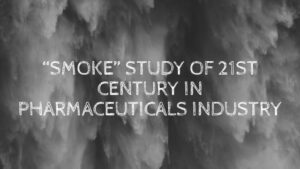Overview
Air Flow Pattern or Smoke studies have been one of the interesting areas for the Inspectors, nowadays. There is very low amount of attentions being paid by the organization when we are designing the smoke pattern protocols and reviewing the videotapes. Sometime situations are there companies do not understand how to review the Air Flow Pattern or Smoke study recordings. This article shall explain everything on the topic and bring the clarity on each segment of Air Flow Pattern. It will make Smoke Study so simple.
To have this clearly understood, first we have to underline the objective of performing the Air Flow Pattern Study.
Objective Statement
There are two key objectives for performing Smoke Study:
- To visualize and demonstrate the laminarity or flow directions for UDAF systems
- To simulate the aseptic behaviors & interventions of aseptic personals to support & demonstrate the laminarity of air flow in dynamic conditions.
The moment we understand the objective, we can create & design the acceptance criteria for the study, otherwise not.
| Objective | Evaluation Methodology |
| To visualize and demonstrate the laminarity or flow directions for UDAF systems | Studies should demonstrate laminarity and should be visualized Studies should demonstrate air flow directions or sweeping actions is being visualized over the path of air flow Air Flow pattern should be uniform throughout the overall surface of the HEPA Filter Face. No turbulences should be observed No smoke bubbles should be observed Density Smoke flow should be enough to get captured on videotapes Continues of smoke flow being generated to avoid false interpretation Airflow should be visualized fromHEPA supply filter and should be visualized evacuating through return Filter |
| Objective | Evaluation methodology |
| To simulate the aseptic behaviors & interventions of aseptic personals to support the laminarity of air flow in dynamic conditions | All planned intervention should be performed as per procedure All interventions are not disturbing the air flow pattern of the smoke All interventions are not creating smoke bubbles or turbulences Aseptic Behavior is maintained during the interventions being carried out. No hurdles are prompted by Operators or the Articles being handles during the interventions which poses the hindrances to air flow pattern Operators do not move his body under the laminar air flow. Chronology of interventions is maintained as per the process sequence. |
Rationalizing the Interventions for study
All the interventions which shall be made as a part of protocols should be properly rationalized and derived through risk assessment approach. Preferably, FMEA tools should be used to derive the intervention which poses maximum risks or RPN (Risk Priority Number).
Interventions should be identified from the routine processes including the manufacturing process, sampling process, maintenance processes, validation process, operation process etc.
Recording Practices
Videotape or other recording mechanisms have been found to be useful in assessing airflow initially as well as facilitating evaluation of subsequent equipment configuration.
Videotapes should be date and time stamped to build the confidence to the activity that they have been recorded in the real time.
All videotapes (raw data) should be properly archived as per the company policy for the storage of raw data along with the processed data.
All recording devices must be equipped with such provision.
Recording personnel should have special training or they should be professional videographers.
Focus should be brought on followings:
- Equipment Name & Number
- Room Name and Number
- Validation /Calibration Tag for the equipment
- Operational limits displayed, if any upon the equipment
- Zoom in and Zoom out status of the area
- Close up scanning of the HEPA filter with the smoke generation device
- Covering all aseptic interventions from the suitable angle of ease and focal length.
Interpretation of Results
Interpretation scale cannot be standard and it can vary organization to organization. However a blind statement should be avoided such as complies/does not comply. Following is an example to calculate the level of compliance during the Air Flow Patter studies.

| Description | Scale |
| Excellent | 5 |
| Very Good | 4 |
| Good | 3 |
| Poor | 2 |
| Very Poor | 1 |
Aberration Handling
Protocol should clearly mention where the corrections shall be triggered.
Where ever required relevant corrections should be made after interpretation of the results. Based upon the criticality of the gaps study should be demonstrated again, if required otherwise suitable corrections can be justified in the report itself.
Recording format should be designed based upon user experience so that relevant justification are captured at the time of the activity such as operational difficulty, angle of recording, smoke density, Lux levels etc.
Decision matrix can be designed as exemplified below:
| Gross Score | Overall Rating | Actions |
| ≥ 61 to 75 | Excellent | No Actions Required |
| ≥ 46 to 59 | Very Good | Actions Required |
| ≥ 31 to 44 | Good | Actions Required |
| ≥ 16 to 29 | Poor | Actions Required & Study to be Demonstrated Again |
| ≤ 15 | Very Poor | Actions Required & Study to be Demonstrated Again |
Smoke Distribution Assemblies
Smoke distribution assemblies should be the integrated part of LAF/ CRAB design so that there is no need to carry and external fitment to perform the Air Flow Studies. These aspects should be evaluated by the Project Team or the Facility Qualification Team at the time of URS preparation.
Do and Don’ts
Sometime, even successfully qualified systems can be compromised by poor personnel, operational, or maintenance practices.
Therefore, practices which should be avoided to prevent turbulences or disturbances in air flow pattern
- Personnel should minimize interventions into the critical zones
- Traffic path for the material movement and man movement should be defined
- Occupancy in each area should be defined and controlled
- Equipment should not obstruct airflow and, in critical areas, its design should not disturb unidirectional airflow.
- Rapid movements can create unacceptable turbulence
- Keep the entire body out of the path of unidirectional airflow
- Maintenance work in clean rooms should be executed with proper care.
Conclusion
To conclude, it is evident that smoke studies have to be demonstrated with sound understanding of the design of the HVAC system and understanding of the Aseptic Behavior. Organization should have specific procedures laid down for conducting the smoke studies. Evaluation should be properly rationalized and a commentary for all activities should be documented with all interpretation of each step and actions recommended.
Subject Matter Experts should be involved for the interpretation of the results for Laminarity and Aseptic Behavior.

Raman is a versatile experienced Bio-pharmaceutical professional with more than 17 year of experience in Sterile and Non-Sterile Formulations. Raman is working in different aspects of Sterile Validations and designing Pharmaceuitcals Quality Systems for the next century. He is a versatile and tech savvy professional who believe the Quality is the foundations of Growing Organizations








